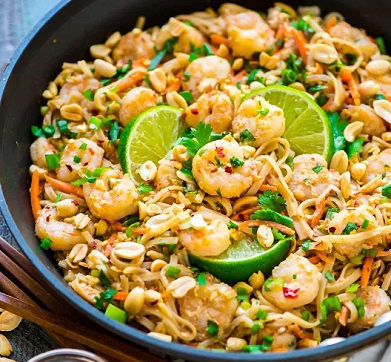Shrimp Pad Thai
Shrimp Pad Thai is a delightful and flavorful dish that hails from Thailand. It’s a staple of Thai cuisine, known for its perfect balance of sweet, sour, salty, and spicy flavors.
This dish features succulent shrimp, stir-fried rice noodles, and a medley of vegetables, all tossed in a tangy sauce and garnished with fresh herbs and crunchy peanuts.
Shrimp Pad Thai is not only delicious but also relatively quick to prepare, making it a great choice for a weeknight dinner or a special occasion.
Follow this recipe to create an authentic Shrimp Pad Thai that will transport your taste buds straight to the streets of Bangkok.
Ingredients
For the Shrimp Pad Thai, you will need the following ingredients:
For the Pad Thai Sauce:
- 3 tablespoons tamarind paste
- 3 tablespoons fish sauce
- 3 tablespoons palm sugar (or brown sugar)
- 2 tablespoons lime juice
- 1 tablespoon soy sauce
- 1 tablespoon Sriracha (optional, for added heat)
For the Noodles and Shrimp:
- 8 ounces rice noodles (flat and wide)
- 1 pound large shrimp, peeled and deveined
- 3 tablespoons vegetable oil, divided
- 2 large eggs, lightly beaten
- 3 cloves garlic, minced
- 1 small shallot, finely chopped
- 1 cup bean sprouts
- 1/2 cup carrots, julienned
- 1/2 cup green onions, cut into 1-inch pieces
- 1/4 cup roasted peanuts, chopped
- 1/4 cup fresh cilantro, chopped
- 1 lime, cut into wedges
How to Make Shrimp Pad Thai
Step 1: Preparing the Pad Thai Sauce
Combine Sauce Ingredients: In a small bowl, mix the tamarind paste, fish sauce, palm sugar, lime juice, soy sauce, and Sriracha (if using). Stir until the sugar is completely dissolved and the sauce is well blended. Set aside.
Step 2: Preparing the Rice Noodles
Soak the Noodles: Place the rice noodles in a large bowl and cover them with warm water. Let them soak for about 20-30 minutes, or until they are soft but still firm to the touch (al dente). Drain the noodles and set aside.
Step 3: Cooking the Shrimp
Heat Oil: In a large wok or skillet, heat 1 tablespoon of vegetable oil over medium-high heat.
Cook the Shrimp: Add the shrimp to the wok and cook for about 2-3 minutes on each side, or until they turn pink and opaque. Remove the shrimp from the wok and set them aside.
Step 4: Stir-Frying the Vegetables and Noodles
Scramble the Eggs: Add another tablespoon of vegetable oil to the wok. Pour in the beaten eggs and cook, stirring gently, until they are scrambled and just set. Push the eggs to one side of the wok.
Sauté Garlic and Shallots: Add the remaining tablespoon of vegetable oil to the wok. Add the minced garlic and chopped shallot, and sauté for about 1-2 minutes, or until fragrant and lightly browned.
Add the Noodles and Sauce: Add the soaked rice noodles to the wok. Pour the prepared Pad Thai sauce over the noodles. Toss everything together to ensure the noodles are evenly coated with the sauce.
Add Vegetables: Add the bean sprouts, julienned carrots, and green onions to the wok. Continue to toss and stir-fry for about 2-3 minutes, or until the vegetables are slightly tender but still crisp.
Step 5: Combining the Ingredients
Return Shrimp to the Wok: Add the cooked shrimp back to the wok. Toss everything together until the shrimp are heated through and well incorporated with the noodles and vegetables.
Add Peanuts and Cilantro: Sprinkle the chopped roasted peanuts and fresh cilantro over the Pad Thai. Give it one final toss to combine all the ingredients.
Step 6: Serving the Dish
Plate the Pad Thai: Transfer the Shrimp Pad Thai to serving plates or a large serving platter.
Garnish and Serve: Garnish with additional roasted peanuts, fresh cilantro, and lime wedges. Serve immediately, allowing each guest to squeeze lime juice over their portion to taste.
Chef’s Notes
Tamarind Paste: Tamarind paste adds a unique sour flavor to Pad Thai. It can be found in Asian grocery stores or online. If you cannot find tamarind paste, substitute with an equal amount of lime juice or rice vinegar for a similar tangy flavor.
Rice Noodles: Be careful not to over-soak the rice noodles. They should be soft but still firm (al dente) as they will continue to cook when stir-fried.
Palm Sugar: Palm sugar has a distinct flavor that is key to authentic Pad Thai. If unavailable, brown sugar is a good substitute.
Shrimp: Fresh shrimp work best for this recipe, but frozen shrimp can also be used. Thaw frozen shrimp completely and pat them dry before cooking.
Vegetables: Feel free to add or substitute other vegetables such as bell peppers, snap peas, or cabbage based on your preference.
Peanuts: Roasted peanuts add a nice crunch and flavor. Make sure to use unsalted peanuts to control the saltiness of the dish.
Nutrition Value
The nutritional values for Shrimp Pad Thai can vary based on the specific ingredients and portion sizes used. Below is an approximate nutritional breakdown per serving (based on a 4-serving recipe):
- Calories: 400-450 kcal
- Protein: 25-30g
- Fat: 15-20g
- Saturated Fat: 2-3g
- Carbohydrates: 45-50g
- Fiber: 3-5g
- Sugars: 10-12g
- Cholesterol: 150-200mg
- Sodium: 1000-1200mg
- Vitamin A: 80-100% DV
- Vitamin C: 30-40% DV
- Calcium: 10-15% DV
- Iron: 15-20% DV
Conclusion
Shrimp Pad Thai is a vibrant and delicious dish that embodies the flavors of Thailand. Its combination of tender shrimp, chewy rice noodles, crunchy vegetables, and tangy sauce makes it a crowd-pleaser for any meal.
This recipe provides a step-by-step guide to creating an authentic and satisfying Shrimp Pad Thai at home.
With its perfect balance of sweet, sour, salty, and spicy, this dish is sure to become a favorite in your culinary repertoire. Enjoy the delightful taste of Shrimp Pad Thai, and happy cooking!
Thanks for visiting Shrimps Recipes

